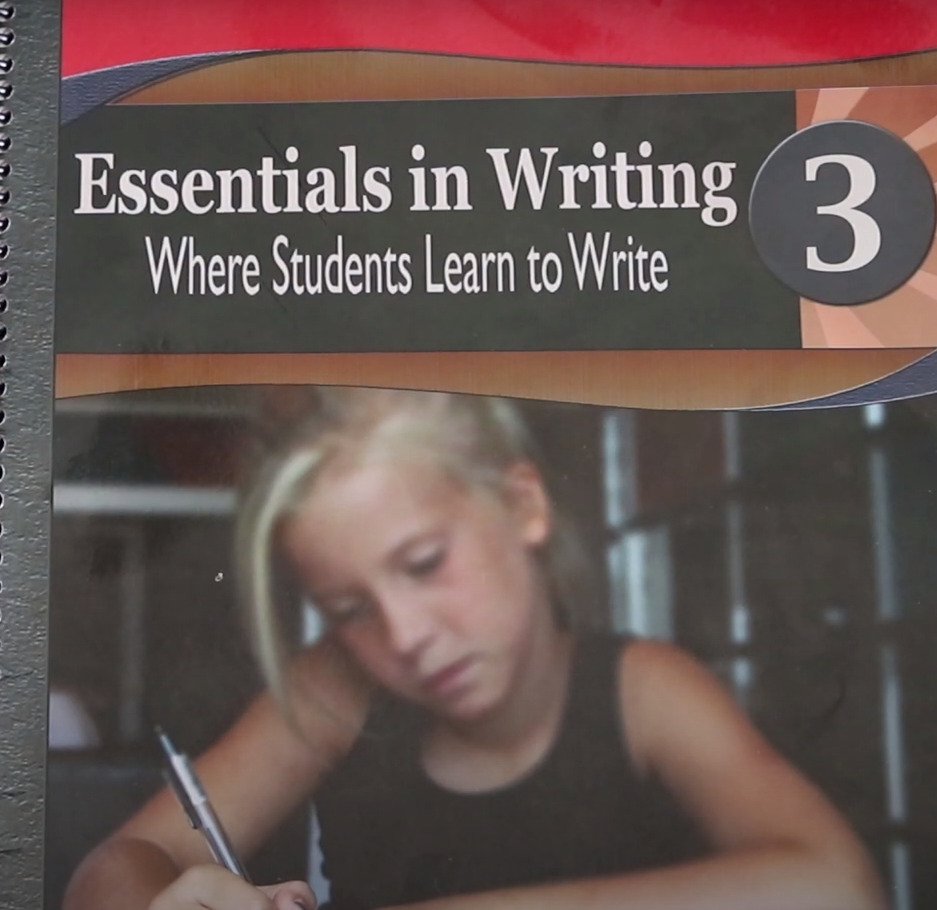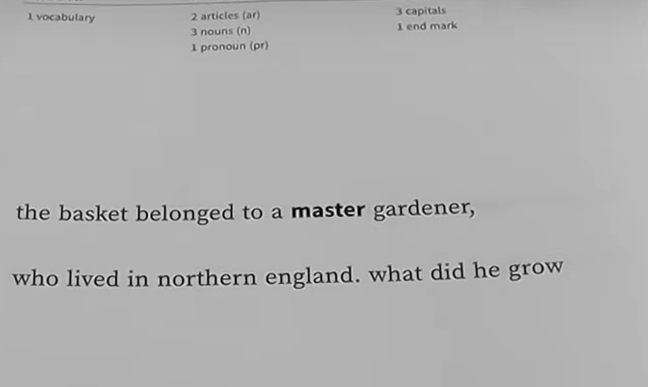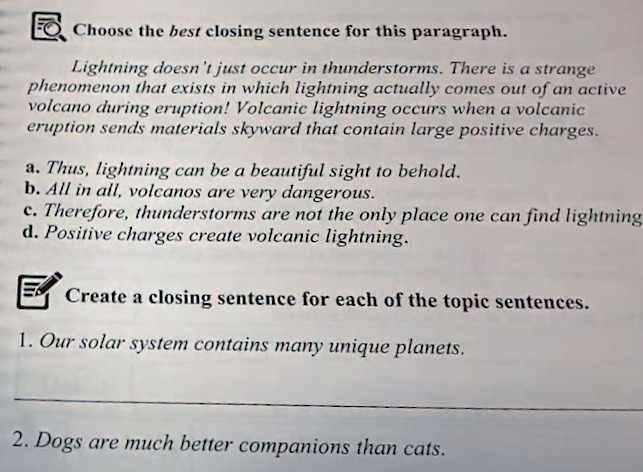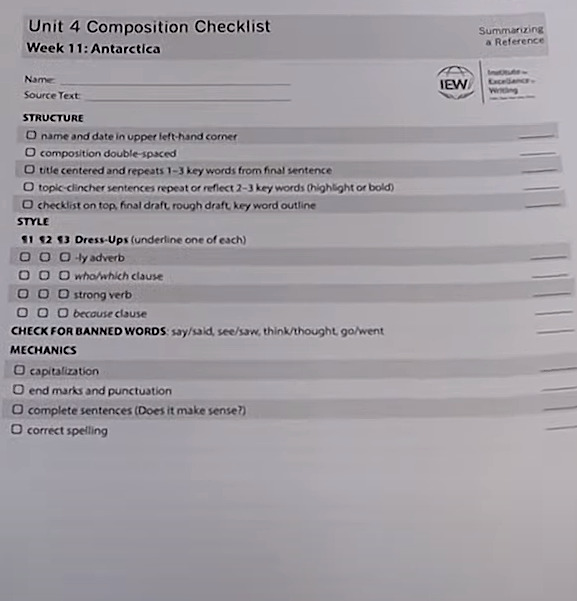Being able to write, and write well, is a critical skill that homeschooling families often struggle with.
For these families, an easy to use, straightforward and comprehensive English writing curriculum can be invaluable.
Essentials in Writing (EIW) and the Institute for Excellence in Writing’s (IEW’s) Structure and Style are two popular, systematic and highly effective video-based writing programs that have helped students since the late 1990s.
Yet, as the two programs share quite a few similarities, it can be hard for parents to choose between them.
To help out, we decided to compare these two great writing programs so that parents can determine which is a better fit for their student.
What is Essentials in Writing (EIW)?
Founded in 1996 by author and teacher Matthew Stephens, Essentials in Writing is a video-based homeschool writing curriculum that teaches elementary, middle and high school students essential grammar and key writing and composition skills.

The Essentials in Writing program teaches through a combination of short videos, workbook exercises, teacher’s manuals and lessons and writing practice.
What is the Institute for Excellence in Writing (IEW)?
Founded by author and former teacher Andrew Pudewa in 1995, the Institute for Excellence in Writing is a language arts curriculum provider that offers a number of solutions for both homeschools and traditional schools alike.

The company’s flagship writing program, Structure and Style, is designed to help students in grades 3-12 learn to write clearly, coherently and effectively using a combination of lively video lessons (for both parents and students), student packets, teacher’s manuals, checklists, charts and other writing-oriented organizational material.
In addition to the main program, the Institute for Excellence in Writing also offers help in grammar instruction (Fix It! Grammar) and reading development tools.
Age Range: How do they Compare?
Both IEW’s Structure and Style and Essentials in Writing are largely aimed at students in elementary through high school.
Essentials in Writing, however, is offered for students in grades 1 through 12, with each of its levels being aimed roughly at a specific grade in this range.
IEW’s Student Structure and Style, however, is aimed at students in grades 3-12, with its first level (SSS Level A) intended for grades 3-5.
As a result, Essentials in Writing can be considered a little more expansive in terms of the grades its main program covers.
That said, IEW does offer a separate course called Primary Arts of Language, which is a full language arts program aimed at grades K-2 and can lead into the main Structure and Style program.
IEW Vs EIW: Writing Course Structure
Institute for Excellence in Writing’s Structure and Style for Students course and Essentials in Writing are structured a little differently.
EIW is composed of 12 levels, each corresponding to a particular grade, and the program largely recommends that most students begin at their intended grade level.
The books rather prominently display their level on the cover, which can make things a bit more uncomfortable for students who are significantly behind in their writing skill.
IEW’s Structure and Style, on the other hand, is made up of three levels – Level A, B and C.
Rather than being intended for any individual grade, each of these lettered levels is aimed at a range of grades.
That is, Level A is aimed at 3-5, B is aimed at 6-8 and C is high school level (9-12).
Each of these levels is then broken down into a couple of years (Level A Year 1, 2, or 3, for example).
While perhaps a little more complex than Essentials in Writing, this structure can be a bit more flexible for homeschoolers working at their own pace and, without as many obvious and specific grade markings, can it be a little less embarrassing to use for students who are a bit behind.
EIW vs IEW: What ELA Subjects and Topics Do They Cover?
Essentials in Writing is primarily a writing course (as can be surmised by the name) but does provide formal instruction and practice in grammar and mechanics.
In its earlier levels, EIW provides distinct units in grammar, and students spend a good deal of time learning predicates, subject/verb agreement, capitalization, proper sentence structuring, adjectives, adverbs, nouns and so on.

As students progress to middle school, grammar instruction largely becomes integrated into the writing process, although there are some optional grammar-specific lessons towards the end of 7/8th grade.
In addition, the company also offers Essentials in Literature, a literary analysis program for middle and high school students.
In contrast, while IEW’s Structure and Style does touch on vocabulary, spelling and essential grammar, its main focus is in writing.
That said, the company does offer supplements that can, when added to Student Structure and Style, provide students with a more full language arts curriculum.
In particular, IEW offers a supplement called Fix it! Grammar, which is actually designed to work with Structure and Style, and teaches students grammar while also teaching them to correct and even improve texts using the techniques they learn in SSS.

In addition, IEW also offers the Phonetic Zoo, which is a comprehensive phonetic spelling program, and Primary Arts of Language, which offers younger students instruction in phonics, comprehension, writing and handwriting.
On the whole, we’d say that EIW centralizes its writing and grammar instruction a bit more (being contained in a single program), while IEW, although perhaps more decentralized, has the potential to be more comprehensive as a language arts curriculum if parents are willing and/or able to purchase the supplements.
One thing that homeschooling parents should note is that neither program really directly teaches sentence diagramming.
In EIW, this is because the program doesn’t believe it to be all that effective for writing.
IEW, on the other hand, recognizes that some students enjoy diagramming but simply teaches sentence analysis in another manner.
How They Approach Teaching English
Video Instruction
Both Essentials in Writing and the Institute for Excellence in Writing’s Structure and Style program make extensive use of video instruction.
In both courses, students are introduced to writing concepts, structures and best practices through recorded, instructor-led videos rather than relying on textbooks or lectures.
In this way, lessons can be a little more multisensory and engaging, and the videos can give parents a break by allowing professional instructors to take over teaching for a while.
Similarly, both EIW and IEW videos are taught by the founders of the programs, Mr. Stephens and Mr. Pudewa, both of whom have extensive experience in teaching writing.
There are, however, some differences in the style and tone of the videos themselves.
IEW’s videos are set in a small classroom with Mr. Pudewa lecturing to and interacting with a small group of kids with the help of whiteboards and various props.
By and large, Mr. Pudewa presents writing concepts and methodology in a very clear, straightforward and step-by-step manner, and uses a good deal of humor to keep kids engaged and interested.
A sample of one of his video lectures can be seen below.
In contrast, EIW’s videos have the company founder and former teacher, Matthew Stephens, standing more or less alone in a replicated classroom, discussing and highlighting various concepts and topics in writing and grammar, often using a whiteboard to model techniques as he goes along.
Although friendly, clear, consistent and enthusiastic, Mr. Stephens uses a bit less humor and more direct demonstration to teach.
The videos also tend to focus more on modeling proper writing and examining the writing process, rather than offering a lot of direct and formal instruction in writing or discussion of its mechanics, which are covered more thoroughly in the workbooks.
Another difference between the two video styles lies in their length.
IEW tends to take a “fewer but longer” approach to its videos.
There are 24 lessons worth and, although it can vary, IEW’s Student Structure and Style videos can be around 30-45 minutes in length.
In contrast, EIW tends to offer quite a few videos per level (between 43-83) and they are considerably shorter, usually under 10 minutes long.
Which approach is better really depends on the student and how reliably they can sit through an instructional video, but it is something that parents should be aware of.
Finally, while EIW only offers videos to students, IEW also offers instructional videos aimed at parents (Teaching Writing: Structure and Style), whose seminar-style videos not only cover the course material but also help demonstrate, explain and elaborate on IEW’s methodology, as well as offering advice, tips and tricks for its proper implementation.
A sort of more dynamic and engaging video teacher’s manual, these seminars are filled with helpful information and tips, which make them very useful for parents who are either new to homeschooling or who are unsure of their own writing/ELA skills.
Interesting and filled with Mr. Pudewa’s humor, the videos can be a lot of fun to watch, as well.
Self-study
There is a slight difference between Essentials in Writing and the Institute for Excellence in Writing in terms of their level of direct parental involvement.
Essentials in Writing is, in our opinion, a little more of a self-study program.
Students start off by watching a lesson video, then read more explicit instructions in their workbooks and then practice what they’ve learned in the workbook exercises or by creating written work in a step-by-step manner.

Parents, in the meantime, can go over, correct and score student work using a rubric or even submit it to the company’s optional Scoring Service, where various professionals correct student work and offer specific and actionable feedback.
Although it does use video to provide the bulk of instruction and take the burden of of parents as well, IEW’s Structure and Style does require a little more parental involvement.
Parents keep up with lesson instruction with Teaching Writing: Structure and Style videos and generally make use of their teacher’s manuals and lesson plans to set the pace, discuss sample texts and student ideas, guide students through lessons, reinforce, review and elaborate on concepts, overseeing the work and correcting written assignments with checklists and so on.
As with many other curricula, as students progress in the series the teacher’s manuals encourage parents to allow them more independence.

Once again, which is better depends on the homeschool and its particular philosophy.
Parents that want a more interactive, hands-on experience may prefer IEW, while those who are perhaps a little pressed for time may lean towards EIW.
Incremental, Structured learning
Both EIW and IEW take a gradual, step-by-step approach to teaching students to write.
Both programs excel at breaking down concepts into more understandable components, with lessons building on one another, with plenty of repetition and review, until students have developed a firm foundation and understanding of writing and the writing process.
Both Essentials in Writing and IEW’s Structure and Style also approach writing in a very structured and systematic way.
In both programs, students are taught explicit rules and frameworks for writing and are given particular methods and tools to organize, structure and edit their work so that writing becomes more of a methodical, understandable and step-by-step process that they can easily recreate and use when needed.

In other words, in these programs students start off with relatively simple sentences and gradually learn to be able to create increasingly complex forms of writing, such as essays.
Interestingly, both IEW and EIW rely heavily on modeling writing, whereby students examine and observe writing process, viewing and working with properly written texts and, in the case of EIW, watching as Mr. Stephens writes and rewrites written work on screen in “real time.”
We believe that Structure and Style uses modeled writing a little more extensively than EIW, however, as students tend to more frequently work with representative source texts throughout their lessons, imitating, recreating, analyzing and learning writing techniques from them, before engaging in creative writing.

Another difference between the programs that we found is that while both programs teach writing in a very systematic and structured manner, EIW tends to be a little more focused on the process of writing, while IEW tends to provide more development in writing style, structure flourishes and expansion techniques.
Editing
Both IEW and EIW are strong proponents of helping students develop strong self-editing skills.
Both programs explicitly teach students a formal process of editing and revision, teaching them to use organized checklists to evaluate their own work before submitting it, helping them develop good academic habits from the start.
Lesson length
Lesson length in any homeschool program really depends on the student and their unique pace of learning.
By and large, however, IEW and EIW are pretty similar in their overall lesson length, usually taking anywhere from 20-40 minutes per day to get through.
Although not particularly short, we don’t feel that either program is particularly overwhelming or challenging for students to sit through.
Price
For the most part, Essentials in Writing is more affordably priced compared to IEW’s Structure and Style.
Its materials are available as both digital and print packages, and cost between $87-127 per year for grades 1-8, and between $67-87 for high school, with optional DVDs costing an additional $15-45 depending on the level.
Structure and Style, on the other hand, tends to cost $169-189 per year, while the Teaching Writing Structure and Style seminar can cost another $189 or so as a one time cost, although the company does frequently run cost-saving bundles that parents should check out.
Summary Table
| Similarities | Differences |
| Both IEW and EIW teaching writing in a systematic, organized and step-by-step manner with guides, charts, checklists and frameworks | EIW teaches grammar as distinct units pretty comprehensively within the program and, later, integrates them into writing. IEW touches on grammar and vocabulary, but parents will probably want to use the supplement Fix It! Grammar to get more thorough grammar instruction. |
| Both programs use video-based instruction | IEW’s videos are longer, use more humor and have an audience that the host interacts with. EIW has a lot of shorter videos and its host models the writing process and explains concepts alone in front of a whiteboard. |
| Both programs offer courses for students in elementary through high school | EIW’s program covers students in grades 1-12. IEW’s Structure and Style aims at students in grades 3-12. |
| Both programs teach writing incrementally and gradually, offering plenty of review and revision | In addition to Structure and Style, IEW offers programs in phonics and handwriting for students in K-2, as well as a phonetic spelling program |
| Both programs’ lessons take about 20-40 minutes to complete | EIW tends to offer more opportunity for self-study, while IEW’s Structure and Style is more parent-led. |
| Both programs strongly emphasize self-editing skills | EIW offers parents the option of subscribing to a Scoring Service that has professionals score student work and offer feedback |
| EIW is divided according to grade range. Structure and Style is divided by grade ranges and makes little mention of grade levels. |
Bottom Line: Deciding Which is Right for You
Both Essentials in Writing and the Institute for Excellence in Writing’s Structure and Style program offer students and parents high quality, thorough and systematic writing instruction.
Both programs are well-known and respected in the homeschool community and have helped tens of thousands of students learn to write properly and effectively in the decades since they were first published.
As they are both high quality programs, it can sometimes be difficult for parents to determine which of the two best first their student’s particular needs.
To help out, we’ve created the chart below that contains some points parents might want to consider before making a purchase.
| I’m a parent and I want… | Consider |
| A writing program that provides plenty of structure and systematic instruction | Either |
| A program that uses lots of short videos and bite size lessons | Essentials in Writing |
| A program that uses in-depth video instruction but uses a little more humor and fun | IEW Structure and Style |
| A curriculum that I can quickly easily add to another ELA spine | Either |
| A writing program with a lot of built in grammar instruction | Essentials in Writing |
| A program with possible instruction in handwriting, grammar, spelling and more | IEW Structure and Style |
| A good deal of review and repetition | Either |
| A program that more easily fits a student who is learning outside of a typical grade progression | IEW Structure and Style |
| A program with gentle, incremental instruction | Either |
| A program that encourages more self-study | Essentials in Writing |
| A program that has a lot of good and guided parent-student interaction | IEW Structure and Style |
| A program that doesn’t require a lot of prep time | Essentials in Writing |
| To be able to send out student work for periodic assessment and feedback | Essentials in Writing |
For More Information
To learn more about these programs you can check out
Our in-depth review of Essentials in Writing
Or visit each company’s website:

About the Author
Anne Miller is the editor of The Smarter Learning Guide and is a passionate advocate for education and educational technology. A mom of two, she majored in English Language and Literature and worked as a substitute teacher and tutor for several years. When not writing she continues to root for the Yankees and the Giants.
